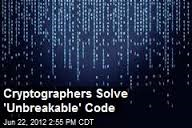
Breaking News
 Holy Awakening Gains Momentum As Biblical 'David' Film Soars At Box Office
Holy Awakening Gains Momentum As Biblical 'David' Film Soars At Box Office
 Trump Halts Five Wind Farms Off the East Coast – 'A major victory for American energy...'
Trump Halts Five Wind Farms Off the East Coast – 'A major victory for American energy...'
 CDC to end animal testing in groundbreaking decision that will impact hundreds of experiments
CDC to end animal testing in groundbreaking decision that will impact hundreds of experiments
 Once-thriving shopping mall in ailing Democrat-run city is eerily empty on last Sunday before...
Once-thriving shopping mall in ailing Democrat-run city is eerily empty on last Sunday before...
Top Tech News
 Perfect Aircrete, Kitchen Ingredients.
Perfect Aircrete, Kitchen Ingredients.
 Futuristic pixel-raising display lets you feel what's onscreen
Futuristic pixel-raising display lets you feel what's onscreen
 Cutting-Edge Facility Generates Pure Water and Hydrogen Fuel from Seawater for Mere Pennies
Cutting-Edge Facility Generates Pure Water and Hydrogen Fuel from Seawater for Mere Pennies
 This tiny dev board is packed with features for ambitious makers
This tiny dev board is packed with features for ambitious makers
 Scientists Discover Gel to Regrow Tooth Enamel
Scientists Discover Gel to Regrow Tooth Enamel
 Vitamin C and Dandelion Root Killing Cancer Cells -- as Former CDC Director Calls for COVID-19...
Vitamin C and Dandelion Root Killing Cancer Cells -- as Former CDC Director Calls for COVID-19...
 Galactic Brain: US firm plans space-based data centers, power grid to challenge China
Galactic Brain: US firm plans space-based data centers, power grid to challenge China
 A microbial cleanup for glyphosate just earned a patent. Here's why that matters
A microbial cleanup for glyphosate just earned a patent. Here's why that matters
 Japan Breaks Internet Speed Record with 5 Million Times Faster Data Transfer
Japan Breaks Internet Speed Record with 5 Million Times Faster Data Transfer
How Cryptographers Will 'Fight Quantum With Quantum'

Two basic types of encryption schemes are used on the internet today. One, known as symmetric-key cryptography, follows the same pattern that people have been using to send secret messages for thousands of years. If Alice wants to send Bob a secret message, they start by getting together somewhere they can't be overheard and agree on a secret key; later, when they are separated, they can use this key to send messages that Eve the eavesdropper can't understand even if she overhears them. This is the sort of encryption used when you set up an online account with your neighborhood bank; you and your bank already know private information about each other, and use that information to set up a secret password to protect your messages.
The second scheme is called public-key cryptography, and it was invented only in the 1970s. As the name suggests, these are systems where Alice and Bob agree on their key, or part of it, by exchanging only public information.

 Advanced Propulsion Resources Part 1 of 2
Advanced Propulsion Resources Part 1 of 2

